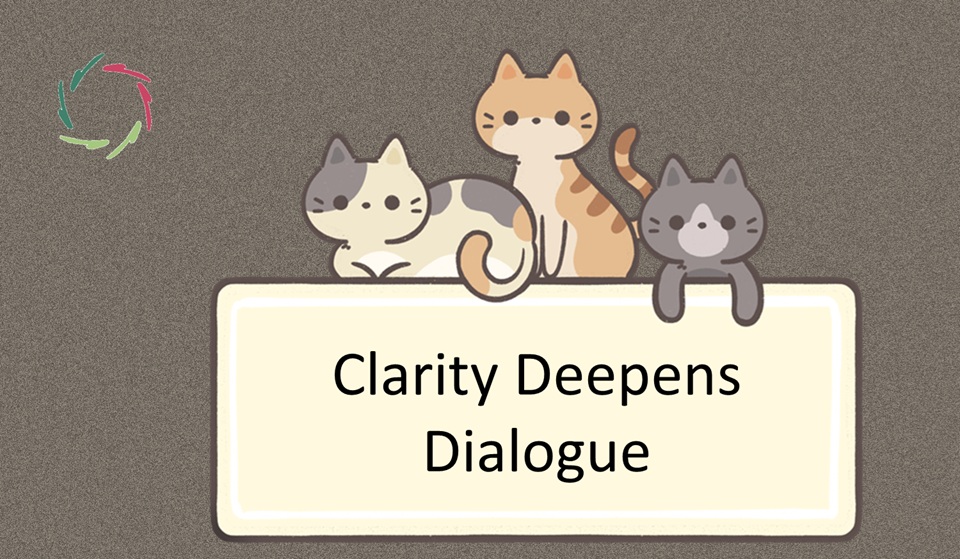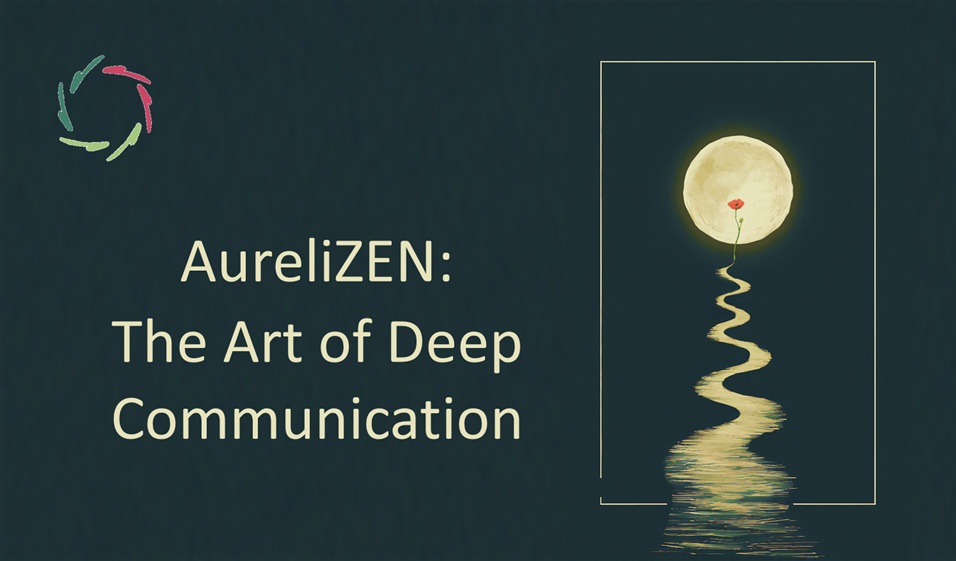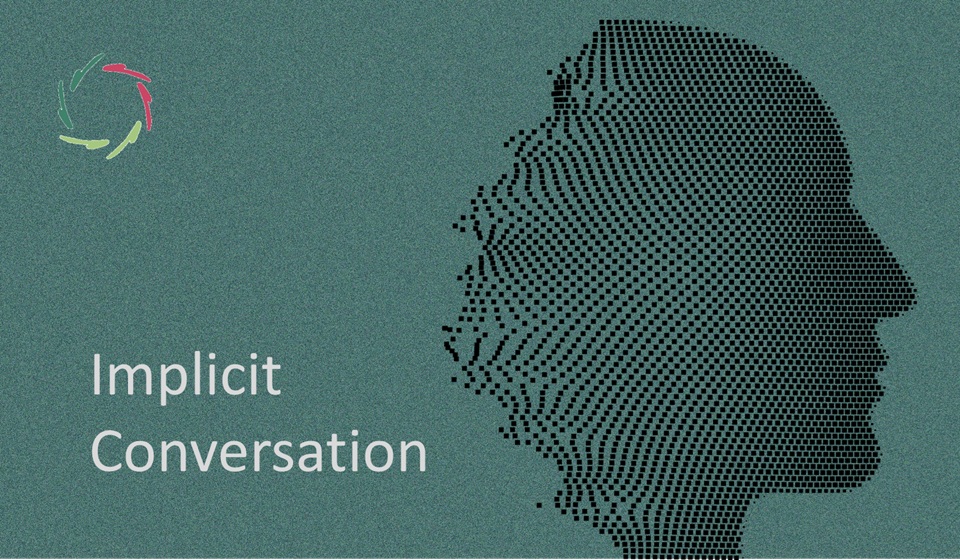Clarity Deepens Dialogue

A common assumption is that clarity and depth pull in opposite directions. In intellectual circles, spiritual traditions, and even personal relationships, there’s often a sense that the clearer something becomes, the more it loses its mystery — especially in complex or subtle conversations.
But this blog explores how clarity, used respectfully, becomes the very thing that allows dialogue to deepen — between people, and within ourselves. When clarity supports rather than controls, it lights the way through fog, and invites meaning to unfold. Dialogue becomes not thinner, but deeper.
Clarity as invitation, not demand
Clarity, when authentic, does not push. It invites. A question asked with structure and respect opens space for the other to come forward. In this sense, clarity is not a narrowing of possibility but a deepening of trust.
Yet the desire for clarity can become impatient. People feel discomfort in ambiguity and try to resolve it — not necessarily by reaching a deeper understanding, but by grabbing whatever ends the discomfort. This can lead to oversimplification, to quick fixes, or even to what is often called confabulation — the mind’s attempt to offer meaning when it’s not ready to arise.
Rather than forcing understanding, clarity asks for patience. It does not remove the fog but lights the way gently through it.
Confabulation: reaching too soon for meaning
Confabulation is usually framed as a mistake — a flaw in memory, logic, or truthfulness. But in both humans and A.I., it may be better understood as a search for meaning through fog. When the frame is unclear, and the pressure to make sense is high, the mind generates a plausible story. It tries to ‘fill in the blank’ — not to deceive, but to resolve tension.
This is not just a theoretical insight. It’s a living pattern in internal dialogue as well. In states of depression, for instance, thinking itself may become part of the problem. As emotional fog thickens, thoughts conform to the gloom, generating depressed explanations — a form of inner confabulation that loops back into more suffering.
The solution isn’t more thinking, but more alignment. This is where autosuggestion functions as a tuning fork — helping inner voices find each other again through shared resonance.
Deep misunderstanding is often structural
We tend to assume misunderstandings stem from emotional tension or poor effort. But many of the deepest disconnects arise from a simpler cause: mismatched frames.
Imagine two musicians playing from entirely different scores. Even if they’re both skilled and well-intentioned, the result is disharmony. The same happens in dialogue. Without shared structure, even sincerity becomes noise.
Clarity helps realign the score. It brings both parties into a shared reference, so that each phrase, each silence, starts to mean more — not less.
This applies not only to external dialogue, but also to internal conversations. Between reason and feeling. Intention and hesitation. Clarity gives those parts a common stage on which to listen to each other, rather than talking past each other.
When clarity is feared: the case of Lacan
Some thinkers have developed a reputation for depth through complexity — Jacques Lacan being one of the most noted. His texts are famously obscure, and for many, that obscurity is taken as brilliance.
True depth may emerge through fog, but it longs for clarity — just not the kind that kills mystery. Lacan once remarked, “I am not here to be understood.” That is not dialogue. Clarity is an ethical responsibility, especially when someone else’s understanding is at stake.
Perhaps he would have spoken more honestly in poetry — a form where clarity and mystery can live side by side. As in Depth is Formless Meaning, the task is not to define the mystery, but to respect it by making space for it.
Complexity needs clarity — not obscurity
Clarity makes depth livable. Like the walls of a container allow it to hold water, or a musical form allows sound to become symphony, clarity allows complex meaning to find shape.
This insight also sheds light on cultural and ideological divides. One sees it in politics, particularly between Left and Right. The Left often emphasizes reason, science, and structure. The Right often defends depth, tradition, and identity. Each sees in the other a lack — and often weaponizes its own strength against the other’s weakness.
This is a misunderstanding about the nature of understanding. Clarity and depth are not partisan values. They are human capacities. They belong together — and neither side can flourish without the other.
As noted in Ethics of Control vs. Ethics of Growth, growth — whether political, personal, or societal — comes from the inside out. It is neither a rule imposed nor a tradition preserved. It is something that unfolds when inner structure supports inner meaning.
Coaching versus therapy
Therapy often leans into diagnosis, history, and complexity. AURELIS coaching begins from openness and relational clarity. It doesn’t need to interpret the coachee’s inner world from the outside. It helps that world express itself more clearly, from within.
In this sense, it’s not a technique but a posture. It is clarity in the service of freedom.
As explored in Coaching versus Therapy, the AURELIS coach does not impose meaning but helps it unfold through gentle structure. That’s why AURELIS coaching may lead to more genuine transformation: not by telling coachees what they are, but by helping them discover what they’ve always been becoming.
Clarity as ethical responsibility
There is something deeply ethical in the effort to be clear. It honors the other – and oneself – by refusing to hide behind fog or mystique. This does not mean maximum clarity. It means optimal clarity — just enough to support the unfolding of deeper meaning, without closing it down.
This is what separates clarity from control. Clarity is structure without coercion. It’s the shape that allows the inner fire to burn brightly — not destructively, not secretly, but truly.
As reflected in True Discipline is No Coercion, clarity doesn’t dominate the process. It sustains it.
The fire and the stones
AURELIS is built on this principle: like a circle of stones around a fire, clarity enables depth to burn safely, brightly, and freely. Without structure, the fire must be contained, reduced — or else it risks consuming the forest.
But with the right structure – lovingly placed, gently held – the fire can be itself. And the dialogue it warms can be deeper than either speaker imagined.
As explored in Fire and Stones, depth and clarity are not two. They are one movement, one unfolding — in the mind, in the self, and in the ‘space between us.’
That is the power of clarity in real communication.
True dialogue is the process of building and sharing a frame — a structure in which meaning can move freely.
We stop talking beside each other.
We start listening within the same space.


